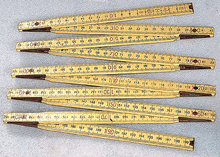Centimetre
A centimetre (international spelling) or centimeter (American spelling) (SI symbol cm) is a unit of length in the metric system, equal to one hundredth of a metre, centi being the SI prefix for a factor of 1/100.[1] The centimetre was the base unit of length in the now deprecated centimetre–gram–second (CGS) system of units.
| centimetre | |
|---|---|
 A carpenter's ruler with centimetre divisions | |
| General information | |
| Unit system | metric |
| Unit of | length |
| Symbol | cm |
| Conversions | |
| 1 cm in ... | ... is equal to ... |
| SI units | 10 mm |
| imperial & US system | ~0.3937 in |
| Look up centimetre in Wiktionary, the free dictionary. |
Though for many physical quantities, SI prefixes for factors of 103—like milli- and kilo-—are often preferred by technicians, the centimetre remains a practical unit of length for many everyday measurements. A centimetre is approximately the width of the fingernail of an average adult person.
Equivalence to other units of length
1 centimetre = 10 millimetres = 0.01 metres = 0.39370078740157480314960629921259842519685 inches (There are exactly 2.54 centimetres in one inch.)
One millilitre is defined as one cubic centimetre, under the SI system of units.
Other uses
In addition to its use in the measurement of length, the centimetre is used:
- sometimes, to report the level of rainfall as measured by a rain gauge [2]
- in the CGS system, the centimetre is used to measure capacitance, where 1 cm of capacitance = 1.113×10−12 farads[3]
- in maps, centimetres are used to make conversions from map scale to real world scale (kilometres)
- to represent second moment of areas (cm4)
- as the inverse of the kayser, a CGS unit, and thus a non-SI metric unit of wavenumber: 1 kayser = 1 wave per centimetre; or, more generally, (wavenumber in kaysers) = 1/(wavelength in centimetres). The SI unit of wavenumber is the inverse metre, m−1.
Unicode symbols
For the purposes of compatibility with Chinese, Japanese and Korean (CJK) characters, Unicode has symbols for:[4]
- centimetre (㎝) – code 339D
- square centimetre (㎠) – code 33A0
- cubic centimetre (㎤) – code 33A4
They are mostly used only with East Asian fixed-width CJK fonts, because they are equal in size to one Chinese character.
See also
- 1 E-2 m
- Conversion of units, for comparison with other units of length
- Reciprocal centimetre
- Orders of magnitude (length)
References
- "Decimal multiples and submultiples of SI units". Bureau International des Poids et Mesures. 2014. Retrieved 5 July 2015.
- Rain Measurement, Rain Gauge, Wireless Rain Gauge, Rain Gage, Rain Gauge Data
- Capacitance - from Eric Weisstein's World of Physics
- CJK Compatibility excerpt from The Unicode Standard, Version 10.0.